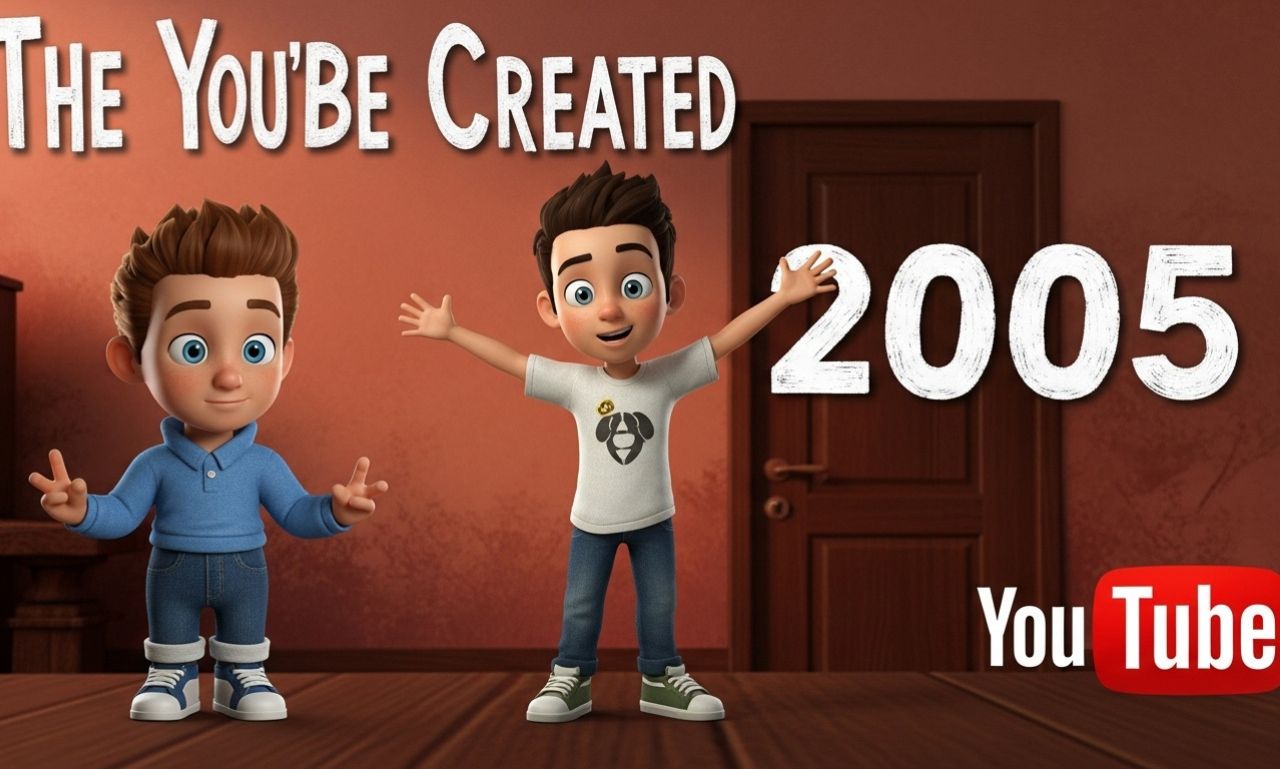The question “when was YouTube created” goes beyond a simple date—it marks the birth of one of the internet’s most influential platforms. The phrase “when was YouTube created” guides our exploration, revealing that three former PayPal employees founded YouTube on February 14, 2005, when they registered its domain name.
Although the platform became publicly accessible slightly later (in beta form in April/May 2005), the creation date sets the stage for what followed.
In this article, we’ll explore not just the creation date, but the context, the founders, the early growth, the acquisition by Google, and its impact up to today—capturing how YouTube became a global video-sharing phenomenon.
Origins and motivation behind when was YouTube created
The story of when was YouTube created begins with three key individuals: Chad Hurley, Steve Chen, and Jawed Karim, who worked together at PayPal.
At the time of the platform’s creation, none of them could have predicted the scale and influence the site would eventually achieve. One commonly recounted story is that Karim struggled to find video clips of the famous 2004 Super Bowl halftime show incident online—this frustration helped crystallize the idea for a video-sharing site.
Originally, the concept was even more niche: YouTube’s founders initially considered a “video dating” site under the working name “Tune In, Hook Up”, where users could upload videos introducing themselves. But very early on they pivoted to a broader video-sharing approach, recognizing the potential of user-generated content.
Domain registration and early launch – when was YouTube created?
The domain “youtube.com” was registered on February 14, 2005—yes, Valentine’s Day. That date is widely taken as the official creation date of YouTube.
Shortly after registration, the founders began developing the site above a pizzeria and Japanese restaurant in San Mateo, California.
The beta version of the site opened around April 23, 2005, when the first video — titled “Me at the zoo” — was uploaded by Karim.
By December 15, 2005, the platform had moved out of beta and launched officially to the public.
So while the creation technically begins on February 14, the full public rollout came later that year.
What does the date tell us about when was YouTube created and its early vision?
The specific date of creation (February 2005) tells us several things:
-
The founders moved quickly. From domain registration to first upload in just a few months.
-
The timing coincided with improving broadband infrastructure and increasing consumer video-capability, making the idea viable.
-
The initial vision was simple: make it easy for anyone—not just tech experts—to upload, view, comment, and share videos.
-
While many early sites existed for photo-sharing, the domain for video-sharing at scale was relatively open—YouTube entered at the right moment.
-
The pivot from dating-based notion to general sharing hints at how the market revealed itself quickly.
Thus the date marks the transition from concept to creation, from idea to actual platform.
Why the question when was YouTube created still matters today
You might ask: does it matter exactly when YouTube was created? I argue yes—because the creation date anchors our understanding of its evolution, its place in tech history, and the speed of change in online media.
-
Historical context: Knowing YouTube was created in early 2005 shows how recent the era of user-generated video actually is.
-
Business insight: The timeline from creation to acquisition (just over a year) shows how fast digital platforms can scale.
-
Technological shift: The date tells us that YouTube emerged at the line between Web 1.0 and Web 2.0—the shift to interactive, collaborative web.
-
Cultural effect: The platform’s creation date helps explain how quickly video became ubiquitous in everyday communication.
-
Planning and strategy: For creators, brands, and educators, knowing the roots of YouTube helps one anticipate trends and changes.
In short, “when was YouTube created” serves as more than curiosity—it informs our view of digital culture.
Challenges after when was YouTube created: growth, copyright, monetization
Of course, once YouTube existed, many bigger issues followed. From the moment of creation, the founders and then Google faced technical, legal, and business challenges.
-
Scaling video infrastructure: At creation, video streaming was heavy in bandwidth and hardware cost. Making video upload and playback smooth was a major hurdle.
-
Copyright issues: Soon after launch, content owners noticed unlicensed uploads and legal pressure grew—this became a major factor in how YouTube evolved.
-
Monetization and business model: Building a sustainable model of advertising, partner revenue and creator payment took years to mature—from the moment of creation onward.
-
Content moderation and community concerns: As more people joined after the creation, moderating content, maintaining community standards, and handling abuse became critical.
-
Competitive and regulatory pressures: As YouTube’s creation turned into dominance, regulators and competitors challenged its power and reach.
Thus the date of creation marks the starting line not only of YouTube’s success but of its many challenges.
How the founders reflect on when was YouTube created
The founders of YouTube have spoken about their origins with some interesting reflections.
-
Jawed Karim noted the difficulty in finding video clips of certain events (like the Super Bowl incident) helped motivate their creation.
-
Chad Hurley focused on the design aspect—making uploading and viewing videos simple for non-tech folks.
-
Steve Chen’s computing background helped build the backend infrastructure in the early days.
They often point to that date in early 2005 as the moment when their idea transitioned into actual work: domain registration, code, initial uploads.
What the phrase when was YouTube created reveals about the digital era
Asking “when was YouTube created” is not just about YouTube—it reflects larger shifts in the digital era.
-
The mid-2000s saw shrinking barriers to video creation and distribution: cameras became cheaper, broadband more widespread, and web tools easier. YouTube’s creation date aligns with that shift.
-
It marks the point when user-generated content moved from niche to mainstream.
-
It suggests how rapidly a startup can become global: creation in 2005, acquisition in 2006, billions of users later.
-
It shows the convergence of design, coding, community and commerce in one platform.
In short, the date is a marker of cultural and technological change.
Beyond the date: what YouTube has become since being created
While the question begins with “when was YouTube created”, the story continues with what it has become.
Today, YouTube is:
-
A platform with billions of videos and hundreds of millions of creators.
-
A business with advertising, subscription models (Premium, Music), and creator monetization systems.
-
A cultural force influencing education, entertainment, news, and social discourse.
-
A reference point for how digital user-spaces evolve from creation to maturity.
The starting point, that moment of creation, laid the foundation for everything that followed.
Key takeaways
Let’s summarise the essential points:
-
The domain was registered on February 14, 2005, marking the creation of YouTube.
-
The first video upload followed in April 2005, and public beta in May 2005.
-
Official public launch came in December 2005.
-
Acquisition by Google occurred in 2006, just over a year after the creation.
-
The date reflects not only the platform’s origin but a broader shift in online media.
If you ever wonder “when was YouTube created”, you now know it was in early 2005—and that date carries far more meaning than simply a timestamp.
FAQs
When was YouTube created exactly?
YouTube was created on February 14, 2005 when its domain was registered and the platform’s idea formally launched.
Why is February 14, 2005 cited as the creation date?
That is the date when the domain name and trademark registration occurred, marking the founding of the company.
When was the first YouTube video uploaded?
When did YouTube become publicly available?
YouTube launched its public beta around May 2005, and officially launched out of beta on December 15, 2005.
Who created YouTube?
YouTube was created by three former PayPal employees: Chad Hurley, Steve Chen and Jawed Karim.
What significance does the creation date hold?
It marks the start of a video-sharing era, signals the rapid rise of digital media, and anchors the timeline of technology, culture and business around YouTube’s launch and growth.
Conclusion
Though “when was YouTube created” may sound like a simple query, it reveals a rich narrative of startup beginnings, rapid growth, global influence, and lasting change. As you reflect on that date and its meaning, you appreciate not only YouTube’s origin—but the broader digital evolution it helped accelerate.

